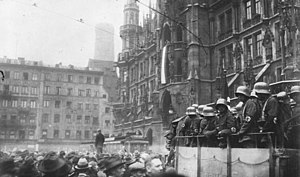Munich Putsch
| Beer Hall Putsch | |||||||||
|---|---|---|---|---|---|---|---|---|---|
 The Marienplatz in Munich during the Beer Hall Putsch. |
|||||||||
|
|||||||||
| Insurgents-Government | |||||||||
| Commanders and leaders | |||||||||
| Military support | |||||||||
| 2,000+ | 130 | ||||||||
| Casualties and losses | |||||||||
| 16 killed About a dozen injured Many captured and imprisoned |
4 killed Several wounded |
||||||||
The Beer Hall Putsch, also known as the Munich Putsch, and, in German, as the Hitlerputsch or Hitler-Ludendorff-Putsch, was a failed coup attempt by the Nazi Party leader Adolf Hitler — along with Generalquartiermeister Erich Ludendorff and other Kampfbund leaders — to seize power in Munich, Bavaria, during 8–9 November 1923. About two thousand Nazis marched to the centre of Munich, where they confronted the police, which resulted in the death of 16 Nazis and four police officers. Hitler himself was not wounded during the clash, although he locked his left arm with the right arm of Max Erwin von Scheubner-Richter who, when he was shot and killed, pulled Hitler to the pavement with him. Hitler escaped immediate arrest and was spirited off to safety in the countryside. After two days, Hitler was arrested and charged with treason.
...
Wikipedia
